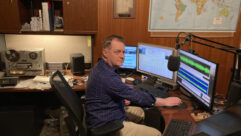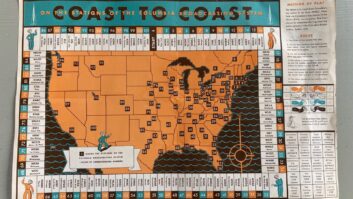
The staff of SW Radio Africa. Credit: SWRA.
OTTAWA, Ontario — Unlicensed “pirate” radio stations are thriving in the Internet age, despite the fact that most people can now operate their own Web-based radio stations without risking arrest.
“A vibrant pirate radio scene continues in the United States, and also in Europe and to a lesser extent in South America,” said George Zeller, a pirate radio listener/journalist for the past four decades.
“This includes a very energetic pirate radio scene on shortwave, and also a stunningly resilient pirate radio scene on FM and to a lesser extent on medium wave, despite the frequent busts by the FCC of FM pirates.”
STILL A NEED
“There is most certainly a place for ‘pirate’ radio today — although I would debate the word pirate,” said Gerry Jackson. She is the founder and station manager of SW Radio Africa, a pro-democracy station broadcasting into Zimbabwe from an out-of-country transmitter. “We are a normal radio station, producing news and information to help inform Zimbabweans in-country.”
So why does SWRA pay hefty electricity bills to broadcast on 4880 kHz, rather than just streaming its content to Zimbabwe via the Web?
“The age of the Internet is far from global,” Jackson said. “Zimbabweans have access to very poor bandwidth, unless they are very rich. Plus 90 percent of the population lives in rural areas where there will be virtually no access to the Internet.”
She added that there is 90 percent unemployment in Zimbabwe, which effectively bars the majority from using whatever Web access is available. In contrast, “shortwave radio reaches all parts of the country,” said Jackson. “If one person in your village has a radio, then everyone can listen.”

Famed pirate broadcaster Allan Weiner. Credit: Allan Weiner WHY THE PIRATES DO IT
There are many kinds of “pirate radio” stations. They run the gamut from hobbyists broadcasting to their apartment buildings using a low-powered transmitter, MP3 player and cheap microphone to full-blown professional operations, such as SWRA. Pirate radio stations are also big in major urban centers such as New York and London, where they tend to lurk at the bottom of the FM bands.
Many pirate stations have been on-air for decades, said Pat Murphy. He is a long-time mainstream radio/TV broadcaster in Washington, D.C., pirate radio listener and volunteer with the Free Radio Network pirate radio fan website. Long-running pirate stations include “Undercover Radio, WBNY(AM) (Radio Bunny), Radio Jamba, Wolverine Radio, Channel Z, Blue Ocean, Rave on Radio, Red Mercury Labs, [shortwave station] WMPR, Radio Free Speech, Captain Ganja, Southern Relay Service to name just a few,” Murphy said.
PERSISTENCE
“Some stations specialize in music, others in commentary and talk. WBNY(AM) is run by a pirate operator who calls himself Commander Bunny and has a rabbit-sounding voice, has run for president —– with bumper stickers to boot — and is actively sending out QSL cards (station confirmation of listener reception reports).”
So why do pirate broadcasters risk fines and even jail to broadcast without a license?

A ‘QSL’ issued by Weiner’s Radio Newyork International/RNI on shortwave radio. Credit: Allan Weiner “I think the ‘motives’ are different for each person,” Murphy said. “Some do it for the thrill of it, others to lend a voice to something they feel the mainstream media has ignored, and others do it for the fun of it.”
In the case of legendary pirate broadcaster Allan Weiner — operator of Radio Newyork International, which broadcast off the New York Atlantic coast using ship-based transmitters in the 1980s — the motivation was exercising his U.S. right to “freedom of speech.” “My friends and I had tried to open our own station legally, but were laughed off by the FCC because we were young and not rich,” Weiner said. “Pirate radio was the only option not just for exercising this right, but allowing other ordinary Americans to speak their minds on the radio, and to let everyone have the chance to hear them.”
Ironically, after decades of pirate broadcasting, in 1998 Weiner succeeded in attaining FCC licenses for shortwave radio station WBCQ and WREM(AM), now WXME(AM); both in Monticello, Maine. Today, he legally owns and operates these two stations, plus WBCQ(FM) in the same town.
In large U.S. conurbations such as Miami, New York/New Jersey and the Boston area, the majority of pirate radio stations “are operated within communities that have been effectively priced out of access to the legal airwaves,” said John Anderson, an American academic who has extensively studied pirate radio and operates the site www.dyimedia.net. “Many of them are commercial, providing an affordable advertising outlet for local businesses,” he said.

Teenage pirate Weiner broadcasting as Free Radio WXMN(AM) in 1971. Credit: Allan Weiner. BOOST FROM THE WEB
As for the risk of being caught? At least in the U.S., “the FCC is really a paper tiger,” Anderson said. “Field offices are woefully understaffed, and busting pirates is just one small duty that field agents are responsible for.”
U.S. fines for unlicensed broadcasting can go as high as $25,000, but since the FCC is mandated to reduce fines for people who can prove they can’t pay, “five-digit forfeitures get whittled down to $1,000 or less,” he said. Add the fact that the FCC doesn’t have the same collection teeth as the IRS, plus a five-year statute of limitations on FCC fines, and “it’s not unheard of for forfeitures to simply expire.”
At first blush, one would expect to have cut into the pool of potential pirate broadcasters. After all, sites such as Ustream.tv and Justin.tv let anyone produce and stream their own audio and video content, for free.
That said, the Web can’t match radio’s ability to provide one-to-many coverage immediately and accessibly, said Weiner. “There is also a magic to just going live on-air that the Web doesn’t deliver. That’s the magic of radio, and there is nothing like it.”
Meanwhile, the Web has proven to be a boon to pirate radio broadcasters in a number of ways. “For instance, they no longer have to risk either locating their studio with their transmitter or antenna — because the latter is what gets found and seized when regulators track down pirate signals — or using STL links to tie the two together, said Paul Riismandel. He is a noted pirate radio journalist and co-founder of www.radiosurvivor.com, a radio news site.

WBNY(AM) ‘Radio Bunny’ souvenirs and QSLs. Credit: Pat Murphy. “With the Web, a pirate broadcaster can simply stream his or her content to the transmitter. If it gets found and seized, the pirate’s production center remains undiscovered and secure.”
The Web is a great place for pirate radio listeners to band together in chat rooms, to share information about stations that are popular, or even on-air right now. For broadcasters, the Web is also a source of easy-to-access, cheap and complete radio stations. “You can now buy a full setup from the Internet for $200,” said Weiner. “When I started as a teenage pirate in the 1970s, broadcasting equipment was nearly impossible to find, and what was available was prohibitively expensive.”
Finally, the Web has made it much easier and far safer for pirate radio broadcasters to respond to listener reception reports — the only proof these broadcasters get that someone is actually tuning in to their signals. “It brought about e-QSLs,” said Murphy. “Instead of sending your report to a mail drop, you would send it to an email address and in return get a verification via email as an e-QSL.”

WBNY(AM) Radio Bunny logo. Credit: Pat Murphy Mail drops were anonymous locations where listeners could send their written reception reports. They were used to prevent giving out pirate radio station addresses over the air, where the FCC might hear them.
The moral to this tale — the Internet age has not reduced potential pirates’ urge to broadcast. After all, “going online requires an expensive device and a monthly connection plan, some of which come with data caps,” Anderson said. “Contrast that to radio, which I can get with an inexpensive receiver and no recurring charge,” he said.
“Even today, nothing can touch radio for its reach, immediacy and intimacy,” said Weiner. “This is why the Web is a boon to pirate radio broadcasters, not a bust.”
James Careless reports on the industry for Radio World from Ottawa, Ontario, Canada.










